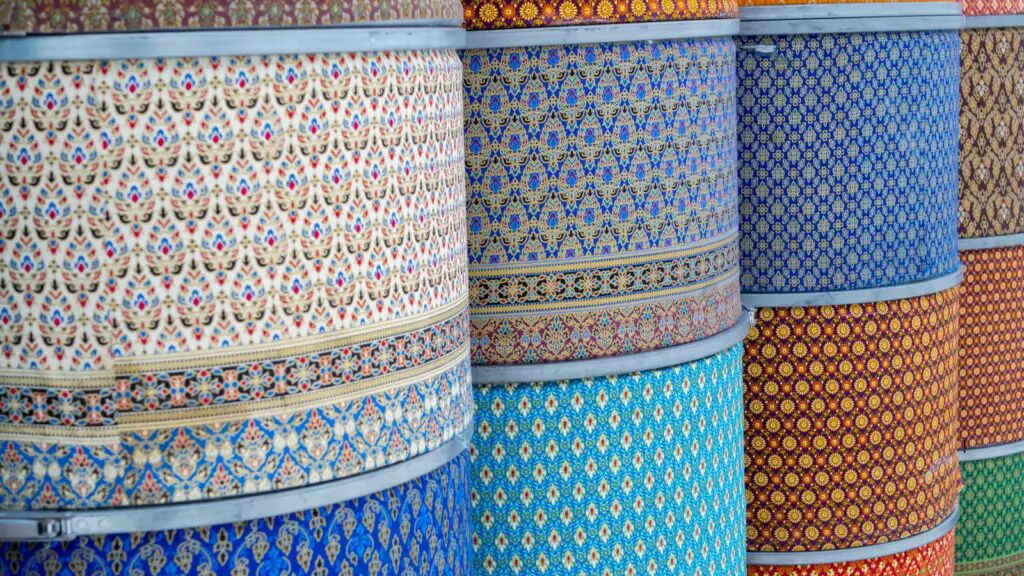Silk is an exquisite and delicate fabric synonymous with luxury, elegance and sophistication for centuries.
Taking care of this natural fiber, which is both strong and fragile at the same time, requires special attention and caution.
For those seeking a gentle solution, Woolite is often mentioned as a potential candidate for washing silk garments.
But is Woolite truly safe for silk?
In this article, we delve into the nuances of silk fabric care, investigate the composition of Woolite, and explore whether this popular detergent is the ideal choice for preserving your cherished silk items.

Can You Use Woolite On Silk Materials?
Yes, Woolite can be used on silk materials.
Woolite is a gentle detergent specifically designed for delicate fabrics like silk, wool and cashmere.
It is safe to use on these materials because it is formulated with a mild, pH-neutral composition that helps to maintain the integrity of the fabric and prevent damage.
How Do You Wash Silk With Woolite?
To wash silk with Woolite, follow these steps:
Read the care label
Before washing, check the care label on the silk item to ensure it can be hand-washed or machine-washed.
Some silk items might be labeled “dry clean only,” in which case you should follow the manufacturer’s recommendation.
For this guide, we’d be sticking with hand washing because it is the safer option.
Prepare the washing solution
Fill a basin or sink with cold or lukewarm water (never use hot water, as it can cause shrinkage and damage the silk fibers). Add the appropriate amount of Woolite as per the instructions on the bottle. Mix the water and detergent until it’s well combined.
Pre-treat stains (optional)
If there are any visible stains on the silk item, gently dab a small amount of Woolite onto the stain and let it sit for a few minutes before washing. Avoid rubbing the stain, as this can damage the delicate fibers.
Submerge the silk item
Gently place the silk item in the water, making sure it’s fully saturated. Do not overcrowd the basin or sink, as silk needs space to move freely in the water.
Gently agitate
Use your hands to gently move the silk item in the water, allowing the Woolite to penetrate the fabric. Be careful not to twist or wring the silk, as this can damage the fibers.
Soak
Allow the silk item to soak for 5-10 minutes. Do not let it soak for too long, as this can cause the colors to bleed or fade especially if it is saree silk.
Rinse
Gently remove the silk item from the washing solution, and rinse it thoroughly under cold running water until all the detergent is removed. Make sure the water runs clear to ensure no detergent residue remains on the fabric.
Remove excess water
Avoid wringing or twisting the silk item. Instead, gently press or squeeze the fabric to remove excess water. You can also lay the item flat on a clean, dry towel and gently roll the towel to absorb more moisture.
Dry
Unroll the towel and lay the silk item flat on a clean, dry surface away from direct sunlight or heat sources. Allow it to air-dry completely.
Never use a dryer, as the heat can damage the silk fibers.
Follow these tips to ensure a successful wash
- Always test for colorfastness by dabbing a small amount of Woolite on an inconspicuous area of the silk item before washing.
- Use a mesh laundry bag if machine-washing silk items to protect them from tangling or snagging. Choose a gentle or delicate cycle and cold water.
- To maintain the luster and softness of silk, you can add a few drops of white vinegar to the final rinse water.
- Iron the silk item while it’s still slightly damp, using a low heat setting and a pressing cloth to protect the fabric. Iron on the reverse side to avoid damaging the surface.
- Store silk items away from direct sunlight, and use acid-free tissue paper or fabric when folding them to prevent creasing.
What Detergent Should I Use To Wash Silk? Natural Solutions?
There are several other gentle detergents available in the market that can be used to wash silk. Some popular options include:
Forever New Delicate Fabric Wash: This detergent is specially formulated to be gentle on delicate fabrics like silk. It’s biodegradable, phosphate-free, and contains natural ingredients that help to preserve the fabric’s integrity.
The Laundress Delicate Wash: This detergent is specifically designed for delicate fabrics like silk, lace, and satin. It’s non-toxic, biodegradable and free of harsh chemicals that can damage delicate fibers.
Eucalan Fine Fabric Wash: Eucalan is a no-rinse, gentle detergent suitable for silk and other delicate fabrics like wool. It’s formukated with lanolin, which helps to naturally condition and soften the fabric. Eucalan is available in various scents, including a natural, unscented option.
Soak Wash: This is another no-rinse, gentle detergent that’s ideal for washing silk items. It’s available in a variety of scents and is phosphate-free, making it an eco-friendly option.
When it comes to natural solutions for washing silk, you can use the following:
Baby shampoo: Baby shampoos are often mild and gentle, making them suitable for washing silk. Use a small amount of baby shampoo mixed with cold or lukewarm water to wash your silk items following the same steps as you would with a gentle detergent.
White vinegar: You can use white vinegar as a natural fabric softener and to help remove detergent residue during the rinse cycle. Add a few tablespoons of white vinegar to the rinse water, and then rinse your silk item as usual. The vinegar smell will dissipate as the fabric dries.
Mild castile soap: Castile soap is a vegetable-based soap that is free of harsh chemicals and can be used to clean delicate fabrics like silk. Use a small amount of unscented liquid castile soap mixed with water to wash your silk items. Be sure to rinse thoroughly to remove any soap residue.
Regardless of the detergent or natural solution you choose, always follow the care instructions on the silk item’s label and test for colorfastness before washing the entire garment.


